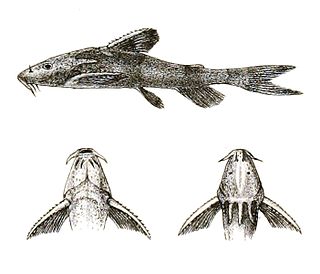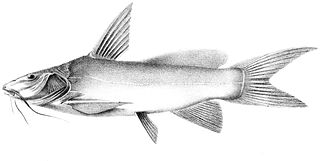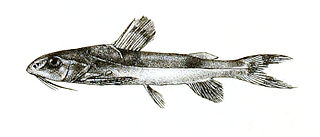
Clarias is a genus of catfishes of the family Clariidae, the airbreathing catfishes. The name is derived from the Greek chlaros, which means lively, in reference to the ability of the fish to live for a long time out of water.

The stream catfishes comprise the family Akysidae of catfishes.

The Ariidae or ariid catfish are a family of catfish that mainly live in marine waters with many freshwater and brackish water species. They are found worldwide in tropical to warm temperate zones. The family includes about 143 species.

Erethistidae are a family of catfishes that originate from southern Asia. It includes about 45 species.

The Anchariidae are a family of catfishes containing two genera, Ancharius and Gogo with 6 species. Anchariids are a strictly freshwater group endemic to Madagascar. Anchariids are characterized by the presence of fringed barbels and a reduced anterior nuchal plate.

Hemibagrus is a genus of catfishes of the family Bagridae.
Caelatoglanis zonatus is a species of catfish of the family Erethistidae. It is the only member of the monotypic genus Caelatoglanis.

Conta is a small genus of South Asian river catfishes native to India and Bangladesh.

Mystus is a genus of fish in the family Bagridae native to Asia. Phylogenetic relationships within this genus are poorly understood, though it has been suggested that there are two major lineages.

Leiocassis is a genus of bagrid catfishes found mostly in Southeast Asia with some species occurring in China.

Pseudobagrus is a genus of bagrid catfishes that inhabit streams and rivers throughout East Asia. About half of these species occur in China.

Ancharius, the Vaonas, is a small genus of catfishes of the family Anchariidae.
Gogo is a small genus of catfishes of the family Anchariidae. It includes four species.

Pseudecheneis is a genus of sisorid catfishes native to Asia.

Gogangra is a genus of sisorid catfishes native to Asia.
Parakysis is a genus of catfishes of the family Akysidae. It includes six species.
Pseudobagarius is a genus of catfishes of the family Akysidae.
Akysis bilustris is a species of catfish belonging to the family Akysidae, known only from two geographically proximate localities in the Xe Kong drainage, a major subdrainage of the Mekong River, in Laos and Cambodia. This species grows to a length of 2.57 centimetres (1.01 in) SL.
Akysis recavus is a species of fish in the family Akysidae, the stream catfishes. It is native to Thailand, where it occurs in the Chao Phraya River. It has also been reported from the Mekong basin in Laos.













